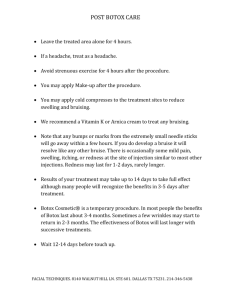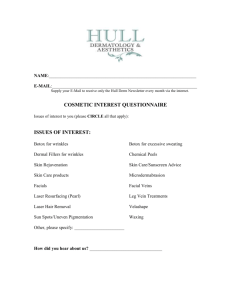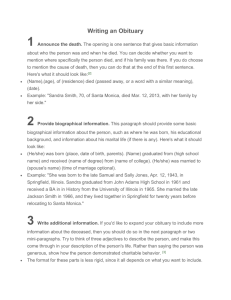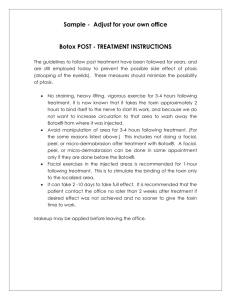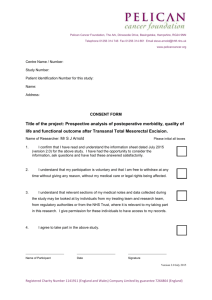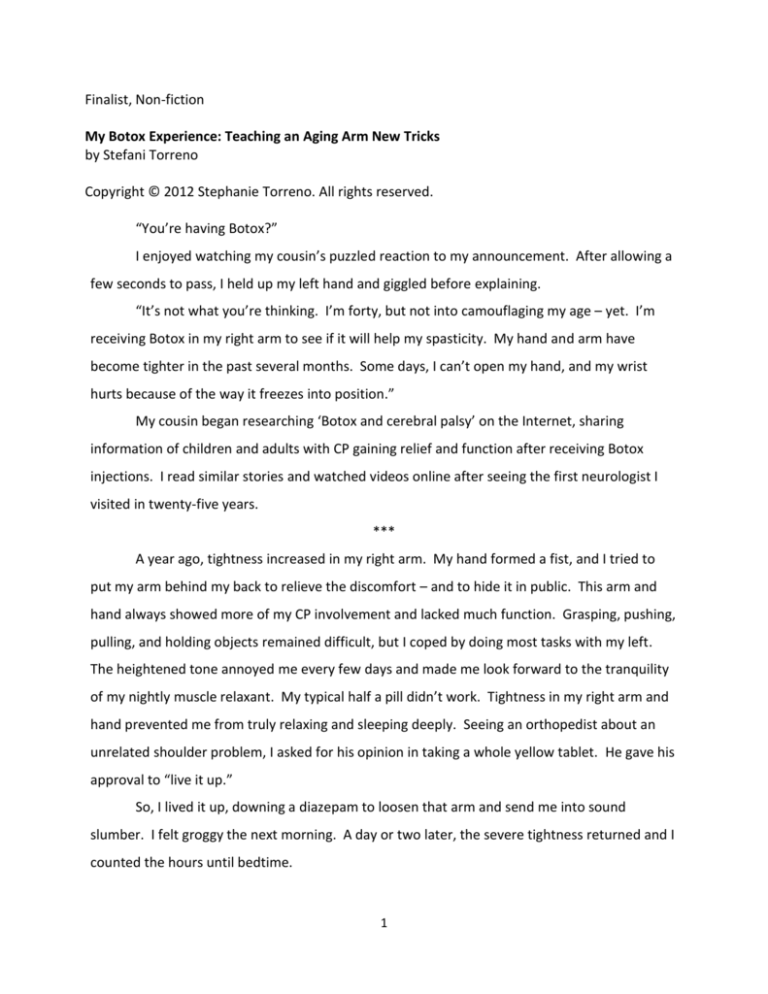
Finalist, Non-fiction
My Botox Experience: Teaching an Aging Arm New Tricks
by Stefani Torreno
Copyright © 2012 Stephanie Torreno. All rights reserved.
“You’re having Botox?”
I enjoyed watching my cousin’s puzzled reaction to my announcement. After allowing a
few seconds to pass, I held up my left hand and giggled before explaining.
“It’s not what you’re thinking. I’m forty, but not into camouflaging my age – yet. I’m
receiving Botox in my right arm to see if it will help my spasticity. My hand and arm have
become tighter in the past several months. Some days, I can’t open my hand, and my wrist
hurts because of the way it freezes into position.”
My cousin began researching ‘Botox and cerebral palsy’ on the Internet, sharing
information of children and adults with CP gaining relief and function after receiving Botox
injections. I read similar stories and watched videos online after seeing the first neurologist I
visited in twenty-five years.
***
A year ago, tightness increased in my right arm. My hand formed a fist, and I tried to
put my arm behind my back to relieve the discomfort – and to hide it in public. This arm and
hand always showed more of my CP involvement and lacked much function. Grasping, pushing,
pulling, and holding objects remained difficult, but I coped by doing most tasks with my left.
The heightened tone annoyed me every few days and made me look forward to the tranquility
of my nightly muscle relaxant. My typical half a pill didn’t work. Tightness in my right arm and
hand prevented me from truly relaxing and sleeping deeply. Seeing an orthopedist about an
unrelated shoulder problem, I asked for his opinion in taking a whole yellow tablet. He gave his
approval to “live it up.”
So, I lived it up, downing a diazepam to loosen that arm and send me into sound
slumber. I felt groggy the next morning. A day or two later, the severe tightness returned and I
counted the hours until bedtime.
1
I decided to make an appointment with my mom’s neurologist, who continues to treat
Mom after the stroke that changed both of our lives. Dr. Jacobs met me once or twice during
Mom’s visits. The doctor told us her aunt had CP.
“It’s good to finally see you. Oh my gosh, you look so much like your mom. I bet you
hear that all of the time,” Dr. Jacobs said as she strolled in the examining room door.
“I do, but I never tire of hearing it. People know I’m Mrs. Torreno’s daughter the minute
I walk into Mom’s nursing home.”
Dr. Jacobs and I spent the first half of the appointment talking about my new
independent life. I described the daily assistance I receive at the townhouse Mom and I once
shared. Grabbing the tissue box behind where I sat and offering it to me, she expressed
sympathy and understanding as tears fell from my eyes when I told her how much I missed my
“former” mom.
During the remainder of my visit, I performed the tasks the doctor asked me to do. I
walked across the room, moved both arms up and down, and open and closed both hands. She
saw the obvious difficulty I experienced with my right side.
“I move more easily when I’m less nervous. I have the white coat syndrome.”
“Do you want me to take it off?” Dr. Jacobs joked. “I think your CP is changing. Your
muscles become tighter as you age. Let’s try the lowest dose of anti-spasticity medication
during the day. It shouldn’t cause sleepiness.”
***
Three months later, I returned to Dr. Jacobs’ office. No, I didn’t experience any side
effects. I didn’t experience any effects, period. She wanted to increase the dosage of
medication, but admitted that oral medicine to control spasticity wasn’t very effective.
“You trusted me with that referral for your well-woman checkup, right?” the doctor
asked.
“Yes, Dr. Hunter gave me a complete exam. He knew how to examine me as quickly and
painlessly as possible. My spasticity didn’t freak him out.”
“Well, I need you to trust me again. I know traveling to the Texas Medical Center is
difficult and time-consuming, but I know a good neurologist who specializes in spasticity. He
2
uses Botox. I would like to see how injections in that arm or hand could relax the muscles, but I
don’t do that. I think he can help you. Will you try to see him?”
***
By the time Dr. Jacobs’ office faxed the paperwork and I scheduled an appointment with
Dr. Fisher, I experimented with the higher dosage of medication for two months. Little relief
resulted.
I decided I wanted to go to the new neurologist alone, so I arranged paratransit to take
me. I gave myself plenty of time and thought I knew where to go. When the minibus dropped
me off at the building next door, I alerted the driver.
“Oh, the bus doesn’t fit under the garage. You’ll have to go into this tower and take the
bridge to that building,” she replied.
“What? I can’t walk that far. Why didn’t someone tell me this when I made the
reservation?”
After the driver saw my frustration, she called the dispatcher to inform him of the
situation.
“Dispatch told me to walk you into this building and an escort will come for you with a
wheelchair.”
The driver made another call on the phone inside the lobby. She said someone would
come in a few minutes. Then, she left.
I couldn’t sit still. I stood up and began pacing with my fists flailing in all directions.
Well, the doctor will see the ideal picture of how tight I become - if I ever make it there.
In the midst of my agitated state, an employee at the desk across from me walked over
and asked if I needed assistance. I tried to explain the problem.
“I’ll take you myself. Let me get a wheelchair.”
Soon, he wheeled me through hallways to one set of elevators. He realized we stood in
front of the wrong elevators and turned the corner to take the correct one to the eighth floor. I
laughed and shared my appreciation of him helping me arrive on time to the Neurology
Institute.
3
I checked in and tried to collect myself in the waiting area. As I sat, a young woman
came over and spoke to me.
“You must be Stephanie. I talked to you last week. They will be right with you.”
I appreciated her acknowledgement. Her kindness made me relax a bit.
Ten minutes later, a woman in scrubs called my name and walked with me to the end of
a hallway. She asked me to step onto the largest, flattest scale I had ever seen. Then, I sat in a
red leather chair while she took my vitals, which didn’t seem as kinky as it sounds.
“The machine won’t read your blood pressure. It doesn’t like the slightest of
movements. I’ll take it manually when we go into a room.”
I could have told her that.
A half an hour passed before I heard a man asking if I had arrived. Dr. Fisher opened the
examining room door, introduced himself, and shared the information Dr. Jacobs gave about
my condition. He listened closely as I added details, and watched as I did what he asked me to
do.
“You know, your muscles are going to continue to tighten with age. You may want to
think about having a Baclofen Pump implanted to control the spasticity. The pump is implanted
along the spinal column and continually delivers the lowest dose of Baclofen.”
“Whoa, Dr. Fisher. I’ve never had surgery. Isn’t that drastic?”
“Yes, but we don’t have to talk about that now. Let’s treat that arm first.”
The doctor went on to tell me information about CP I never knew. He commented on
the swan neck deformity, or the crooked alignment, of my fingers.
“We call your fingers ‘swany’ because they look like a swan’s neck.”
I suddenly felt sorry for myself, realizing the effects of my disability on my aging body.
Dr. Fisher then spoke about my dynamic muscle tone. I had never heard that term
before to describe my muscles, so I asked him to explain it.
“Dynamic muscle tone means your tone constantly changes. You have spasticity in all
four limbs. I see tightness in your jaw, too. We both know, however, that you have athetoid CP
4
– that’s the floppiness in your tone.” Dr. Fisher moved his arms and legs in wave-like motions to
demonstrate my loosy-goosy movements.
“Botox works better on patients who only have the tightness you’re experiencing.
Someone who suffers a stroke, for example, and has one arm locked into position is the best
candidate for effectiveness. So, I cannot guarantee Botox will help you. I think we should try it,
though. I also want you to have some physical therapy.”
Before the doctor walked with me to the desk to schedule my injection, I joked with him
about having a shot in my face.
“No, I don’t do that! And you’re too young.”
My sister agreed to pick me up after my appointment. After becoming confused about
which elevator to take to meet her, I sat on the bench in the busy garage entrance and felt
relieved when I recognized her SUV.
***
A few weeks later, I asked my friend and “adopted” dad, Arnold, if he could pick me up
after my injection on Tuesday. My nerves about transportation and the appointment itself
gripped me over the weekend.
Arnold called me on Sunday evening.
“I can’t let you go alone. Let me take you and accompany you to your appointment. You
don’t need to worry about arriving on time. You need to relax as much as you can.”
I tried to argue with him about acting independent and taking up too much of his time.
Arnold wouldn’t hear it. I felt a little lighter as I hung up the phone.
***
Arnold and I sat in the waiting room looking at a golf magazine together. An ad for
Botox appeared in the first few pages. We read the conditions that Botox treats, with upper
limb spasticity listed. Looking up, I saw Dr. Fisher walking from the hallway to pass where we
sat.
“Oh, you’re here already. I’ll be right back, and we can start.”
One of the nurses came two minutes later. Arnold told me he would go into the
examining room with me and leave before I received the injection.
5
I stood on the wide scale again, and sat in the red chair. As the nurse wheeled the blood
pressure machine toward me, I shook my head.
“That doesn’t work on me. Will you take it manually in the room?”
The nurse agreed and led us to an examining room. Dr. Fisher soon entered the room
with two medical students. He asked if they could stay as he shook my right hand, which had
difficulty with the gesture.
“Yes, they can stay. I’m nervous.”
“I can tell. Your whole body looks tight. Try to relax as much as possible. I need you to
sign a consent form and my assistant will secure payment from you before the procedure. Sit
and try to relax while we come in and out.”
Arnold talked to me between flipping pages. “Judy and I talked about this last night. She
thinks he’ll give you a shot for pain before the injection. Don’t worry; the needle is only eight
inches long.”
“You’re not helping my nerves.”
The doctor returned with papers and explained what I needed to sign. When he left
again, Arnold helped take the stamp I use as a signature out of my purse and press it onto the
paper. I stamped it again on the credit card authorization after the assistant returned with my
Visa.
Dr. Fisher came back and looked at my signature.
“That’s pretty good.”
“She has a stamp,” Arnold showed the doctor.
The doc shot me a smirk and laughed.
“Yes, but I signed my name to have the stamp made. My mom made me practice a lot.”
Before Dr. Fisher left again to retrieve the supplies, Arnold said he would wait in the
waiting room.
“No. You’re going to assist,” the doc informed Arnold.
“I thought I came here to read magazines,” Arnold replied.
6
Eight shots. The doc laid out eight syringes of Botox. He instructed Arnold to sit on the
arm of my chair and hold my arm still. The two female medical students stood in the corner and
watched.
“I’m the Clint Eastwood of shots. I will do this as quickly as I can,” bragged Dr. Fisher.
Pain shot? Forget it. The doctor rubbed my arm with sterile pads before beginning the
injections. I leaned my head against Arnold’s chest and closed my eyes periodically. I heard the
medical students whispering to each other.
What are you saying? Do you mind? I’m trying to concentrate on remaining still.
The door suddenly opened and another physician told my doc he needed to speak to
him.
“I’m a little busy,” Dr. Fisher replied.
Uh, yes, he’s a little busy. Can we finish this soirée first?
With the door closed, the injections continued. Doc bent my elbow so he could inject
the underside of my arm. Arnold held my hand. The shots finally ended. My nervousness
seemed worse than the shots themselves. Dr. Fisher said he would come back as he left the
room with the students. Arnold continued to wipe off the light red stains all over my arm.
The doc returned with pamphlets about the Baclofen pump and asked me to watch the
DVD in one of the packets. He said the Botox may take up to four weeks to work. When I
reminded him about physical therapy, he asked where I lived. He said I would have PT at home
after a nurse made a home visit to enroll me.
“May I keep taking diazepam at night?”
“You can do anything you want.”
He held out his hand to shake mine again, and I felt more confident in my gripping this
time.
“Very good. And remember, your right bicep will look younger!”
After making an appointment to return for another round in three months, I walked
with Arnold to the elevator. He held my hand as we strolled to his car.
***
7
Dr. Fisher had my email address because I asked him a question before the procedure.
That Friday, I received a message from him because the physical therapist couldn’t reach me.
The phone number they had was incorrect. Sandra called Sunday evening to schedule my PT
evaluation. A nurse made a visit before our Wednesday appointment to enroll me into home
health care. She planned to check on me weekly.
Sandra and I clicked from the minute she entered my home. She asked me lots of
questions, both related and unrelated to the purpose at hand, so to speak. Seven days after
the injections, I didn’t feel any effects. Sandra gently manipulated my arm, wrist, hand, and
fingers, and asked me to demonstrate how I moved them. The therapist thought I needed a
splint to wear at night to rest “my poor little wrist.” When I showed her a soft brace I borrowed
from my mom’s carpel tunnel syndrome days that I used occasionally, she looked at me and
chuckled.
“Um, sweetie, that’s for the left hand. The metal part inside the splint goes under the
wrist.”
“Oh.”
Sandra called Dr. Fisher to ask his opinion about a splint. Doc didn’t think I could handle
it, and he worried I might hurt myself more if I wiggled out of the splint in bed.
“He’s wrong,” she said after hanging up her cell. “Let’s prove it to him. I want
something soft to give you some relief. I know a woman who can order you one. May I have
Kristen come to look at your wrist?”
“Of course.”
Sandra asked me to open the drawer under my coffee table. As my right hand missed
the silver knob and I became frustrated, she told me to close my eyes and picture my target.
She guided my hand to the knob and let go. I opened the drawer.
“Beautiful! See, you can do anything you want.”
The therapist said she would like to work with me and would call Sunday to schedule my
first two sessions.
“Monica may work with you, too. She likes playing with hands and arms.”
***
8
The phone rang Sunday evening. Monica introduced herself and gave me possible days
and times to begin PT. She had difficulty understanding my speech on the phone. I felt nervous
since I expected Sandra to work with me first. I wanted to do my best, too. After all, I hadn’t
had physical torture since high school.
Monica understood me easily in person, and we discussed the changes I felt in recent
days. My arm and hand felt more relaxed. Almost paralyzed, in fact. Instead of my nearly
constant fist, my hand didn’t want to close. I also lacked the strength to carry my purse over my
arm.
“That’s okay. The Botox has begun to take effect. You hardly need the stretching I
expected to do. We need to make you stronger.”
After Monica took my vital signs, she manipulated my hand to learn how it functioned –
or didn’t function. I asked her if I could leave the radio playing in the background.
“Yes, I think you need workout music. And I like this station.”
My therapist showed me the range of motion exercises that became my routine.
Monica allowed me to rest after each set of movements. During these breaks, we talked about
anything and everything. Torture then resumed.
“Keep your head up. Look straight ahead,” she reminded me by saying “head”
throughout the first workout. I felt exhausted after forty-five minutes. She warned me about
the agony to come. Weights!
When I informed Monica I had a yoga mat, she smiled and said, “Oh, good. See you
Thursday.”
***
Why delay the inevitable? I found wrist weights in my closet and brought them
downstairs for the next session. Monica and I agreed holding dumbbells wouldn’t work, so I did
the range of motion movements with the weights around my wrists. She wanted both arms to
experience the torment. Enjoyment, I mean.
Following orders, I lay down on the mat and practiced ‘pretend’ push-ups. I say
“pretend” because I may never gain the ability to lift my body off the floor with my arms.
9
Monica wanted me to go through the motions, however, with flat hands on the mat and arms
pumping. If I kneeled on all fours as I pushed up and down, so what?
My weekly two-hour sessions became routine. I looked forward to working out and
feeling stronger with my tormentor – my new friend – as my guide. Monica provided a tune-up
for my whole body.
When I told her about my difficulties using my right hand to help open packages,
Monica said I needed to work on finger strength. She asked me to buy Play-Doh. During the
next therapy session, I squeezed, rolled, twisted, and pinched the colored compound. I formed
balls and hot dogs.
“Okay,” Monica said, “Sandra comes next time to evaluate your progress. Show off for
me.”
***
Sandra sat next to me as I showed her my routine after she put the weights around my
wrists. She thought I needed my scapula stretched, so she leaned me against pillows in the
corner of the sofa and pushed against my shoulder with most of her might. I anticipated pain,
but it didn’t hurt much.
“Raise that arm now.”
My arm reached higher this time.
The therapist turned her attention to the blue and gray splint on the table. She asked
me what I thought of it.
“Kristen delivered it yesterday. The splint is not what I expected. I had difficulty putting
it on myself last night.”
“Well, let me give you some tips and let’s practice.”
Sandra loosened the four wide Velcro straps. She placed a pillow on my lap and laid the
splint on top of it. Demonstrating with her own hand, she showed me how to wiggle my hand
into the contraption. Sandra taught me which straps to tighten first before securing my fingers
between the separators. I then did it myself.
“Easier.”
10
“You don’t need to wear it to bed if you become frustrated. Have your caregiver help
you when she’s here. Try to wear it a few hours per day. I will tell Dr. Fisher about your
continuing progress during our weekly meeting. What else is happening?”
“Monica convinced me to watch that DVD the doc gave me. When I opened the packet,
though, the disk was missing.”
I retrieved the packet next to my TV and showed Sandra. She started laughing.
“This is good. Fisher wants you to watch a DVD about surgery that terrifies you, and he
can’t give you the complete packet!”
Whipping out her cell, Sandra texted the doc. The physical therapist received a response
a few minutes later saying the disk must have fallen out. The doc would give Sandra a DVD for
me on her next visit.
“Can’t wait.”
***
My physical therapy continued. Some days, I thought my back door should revolve for
everyone who visited me – my caregiver, my therapists, and a home health care nurse. Monica
continued to strengthen all of my muscles, and she made the misery pass quickly. She planned
on meeting me at Dr. Fisher’s office for my next Botox treatment, although Sandra thought
Monica might hold my arm with her eyes closed.
Sandra informed me of resources I never knew existed. Her advice and assistance
opened up possibilities to make my complicated life easier. She and Monica worked with me to
increase my independence and to advocate for my needs.
I will return to Dr. Fisher’s office in three months for another round of injections. This
time, I’ll know what to expect and perhaps won’t feel as nervous. I don’t want to rely on my
expectations, however; because I will never know how far my new strength and function will
take me.
11


